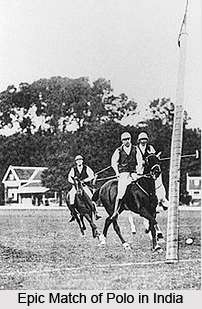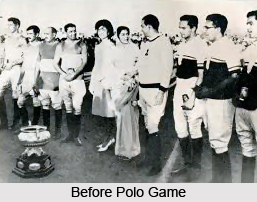 One of the epic matches of polo in India was the match between two titans; Patiala and Jodhpur in 1922. The game marked the downfall of the Patiala Team and rise of the Jodhpur team. The team from Jodhpur reined the polo field for the next three decades. The epic match is described as one of the crucial match to have been played in India during the rule of the princely state. An analysis of the gradual evolution of polo as a tactical game up to this period will show that improvements in the game mainly were in the form of development of what already existed. This was achieved primarily by an increased attention to details and extending the game to its natural conclusion, especially as the keen edge of competition, spurred on by Regimental or National honour was increasingly applied to the sport. Teams came to the top as leaders arose who had the necessary skills in the game to guide and shape the lines of play as well as the capacity for leadership to enforce their view on others. However, the lessons taught by one team were soon forgotten, having to be re-learnt to a great extent by the next due to a failure by the players in general, to grasp the essentials.
One of the epic matches of polo in India was the match between two titans; Patiala and Jodhpur in 1922. The game marked the downfall of the Patiala Team and rise of the Jodhpur team. The team from Jodhpur reined the polo field for the next three decades. The epic match is described as one of the crucial match to have been played in India during the rule of the princely state. An analysis of the gradual evolution of polo as a tactical game up to this period will show that improvements in the game mainly were in the form of development of what already existed. This was achieved primarily by an increased attention to details and extending the game to its natural conclusion, especially as the keen edge of competition, spurred on by Regimental or National honour was increasingly applied to the sport. Teams came to the top as leaders arose who had the necessary skills in the game to guide and shape the lines of play as well as the capacity for leadership to enforce their view on others. However, the lessons taught by one team were soon forgotten, having to be re-learnt to a great extent by the next due to a failure by the players in general, to grasp the essentials.
The atmosphere of that historic match between the Patiala and Jodhpur team were electric. Around 1, 50,000 spectators gathered around the field to witness the match. Many dignitaries gathered to watch the match as well which included future king of England, the Viceroy, some 50 Maharajas and princes, dozens of generals and high government officials and all the ladies dressed as if they were going to be received a court. The atmosphere was perfect for a high voltage match.

Both the teams were ready for the game and were determined to win. Each had their own advantages and strengths. The Jodhpur team had a string of 150 ponies to choose from while Patiala had even greater resources, including a style polo that I can only describe as a chess game, a wonderful control of the ball from all corners of the field. The Jodhpur Team knew that if at all they were to come victorious from the match then they had to outdo their opponents in speed, always playing the ball to an imaginary line straight down the centre of the field from one game to another. That was how it turned out. The Patiala Team were still leading 4-nil in the third chukker, while, just before the interval, late Rao Raja Hanut Singh scored for the Jodhpur Team. Halfway through the chukker Jodhpur scored and drew even at five-all. Three more minutes to go, and through those minutes` men, important major generals and personages in high political office stood up in the grandstand waving their hats and shouting themselves hoarse, and women screamed.
The roars from the crowd were so deafening that none of the players heard the final bugle and they knew the game was over only when thousands of spectators began pouring into the field. There were celebrations all around. Dignitaries from the pavilion rushed out into the field to try to capture the stick as a souvenir.






